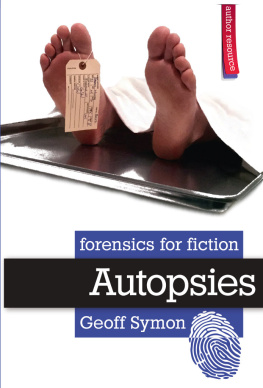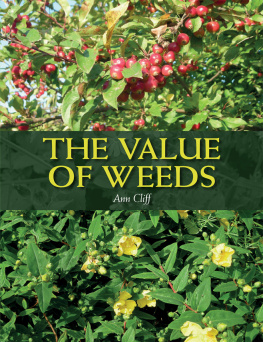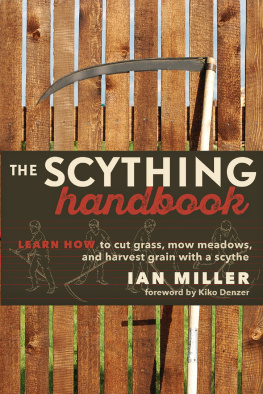Any non-writer who, like myself has attempted to put many elusive concepts and convictions into the fixed form of a book and was left with his immediate family intact, would know that it is the supportive kin who deserve endless gratitude.
Apart from the vast number of people contributing to who I am and what I do, I only know it all started with my mother, Maria and my father, Jozef.
Many have aided my scythe-related quest. Among them, the amazing woman Grith Lerche of Denmark and the New Hampshire dairy farmer and lifelong scythe missionary Hans Eccard seem to stand out as wellsprings of certain strength I have, at times, sorely needed.
Moreover, had it not been for the overwhelming hospitality of the extended working collective (and especially Peter Wagner) at the Franz de Paul Schrockenfux scythe factory, where I learned so much, this written form of my partial know-how would not be.
Nor would it be in your hands now without the necessary arrangements made by Alan Hood and the great patience he subsequently manifested.
This manuscripts first versions were all pencil-written on the backs of once-used papers. After my combats with Kai were settled (or nearly so), Faye typed it up on a manual typewriter. Our friend, neighbor, second editor and proofreader Philip Allen, worked long hours to meticulously transfer the text and the diagrams intowell, yes, I sheepishly admita clear digitized form.
Any lack of clarity in composition you may have been troubled by is due to my stubborn insistence on retaining a mode of expression with sometimes uncommon double meanings and between-the-lines philosophy. The Slovak brain patterns must have long taproots difficult to dig out.
In spite of the integrity with which I have attempted to communicate, I alone am responsible for possible shortcomings regarding the conceptual and technical correctness of this text.
Between 1994 and the time of this writing, I have approached every American scythe importer, including most of the dealers of the European pattern blades and accessories, offering to help. (This was free service; I paid for the hours on the phone and spent time writing many pages of letters.)
Some took me for a rare fanatic and treated me accordingly; some seemed to listen politely, yet continued carrying on as before. Still others wanted suggestions (or so they said), but did not follow them or changed their level of service comparatively little.
Unanimously they were of the opinion that:
- Customers would be confused by too many options.
- The interest in the tool does not justify the cost of printing more detailed catalog descriptions, or the stocking of a diverse inventory.
- Their selection, incomplete though it may be, will suffice for the beginner.
Perhaps I am a naive optimist, partial to the scythe, who believes this tool deserves to be treated on par with those articles where the above-average qualityin terms of service as well as that of the item soldis in demand and therefore provided.
The biggest un-success, to date, I consider to be my experience with a Canadian company which, within the last 20 years, has come to represent exemplary tool quality and service in the realms of woodworking and gardening.
Although I did manage to talk them into adding the scythe to their offerings, I now wish I had not even tried. When their next catalog arrived, I was shocked at the selection: one blade, aluminum snath, stone-holder and one synthetic stone. This may be expected of an impersonal chain store, but not, (by me, at least) from a company that offers, to the world of woodworkers, approximately 250 different chisels and gouges and a vast array of means to sharpen them.
You see, I had, in several previous letters, urged them to sell shorter blades than 28", and suggested that the dependable Amish woodworkers in Ontario could make snaths of Canadian wood and of a better design than any commercially available. I volunteered to writefree of chargea short instructional booklet to be included with each complete scythe sale; they did not take me up on the offer and only later did it dawn on me as to why not.
I would have stated clearlyas I did to the companythat these blades will perform poorly if the edge is not periodically peened. Exasperated, though not yet ready to give up, I called the president on the phone. He told me that, at most, four people in this whole country use the scythe seriously, and, besides, one could not teach the average person today how to cold-shape the edge of a tool, even with the aid of a jig, (the function of which I had previously described to him in detail by means of diagrams in my lengthy letters.) That really floored me. This mans low regard for his fellow Canadians was one thing; the other is that he cannot claim ignorance on the issue of sharpening. As one of the contemporary keen-edge gurus, he wrote an excellent book on the subject. Luckily, he did not discuss the scythe; I wonder how he would have explained, or justified, the use of the whetstone his company sells to sharpen it. Their supplier of scythes and accessories offers five natural and five synthetic stones. They opted for the very cheapest of the latter group.
For now I have run out of the energy required to break through established attitudes and business patterns. Instead, I am focusing on an alternative approachthe planting of seeds at ground level with the vision of establishing a cooperative network in America and in Europe. It will consist of those who, instead of just selling the scythe, would like to learn how to use it well and, by means of workshops, pass the skill on to others. A book is no substitute for a good teacher with the tool in hand, but it is a start. Tresemers The Scythe Book is very inspiring (without being threatening) and fulfills a certain important role. My portion may ruffle a few feathers but also offers a more complete instructional text.
I am presently expanding it further, perhaps beyond the level a casual mower will appreciate (it will also include chapters on freehand peening and snathmaking). In addition, an instructional video is in progress to fill the gap between now and the time of many teachers.
Those willing to help with this extended project can contact us by writing to: Vido Family, 1636 Kintore Road, Lower Kintore, New Brunswick, E7H 2L4, Canada.
Allingham, William. Fifty Modern Poems. London: Bell & Daldy, 1865.
Ardrey, R. L. American Agricultural Implements. New York: Arno Press, 1972 (1894).
Arnold, James. The Shell Book of Country Crafts. London: John Baker, 1968.
Bartenieff, Irmgard, with Dori Lewis. Body Movement: Coping with the Environment. New York: Gordon and Breach, 1980.
Barton, Lela V. Seed Preservation and Longevity. New York: Interscience Publishers, 1961.
Bayerische und Tiroler Sensen-Union. Einige Aufschltisse ber die Sensenherstellung . Landmaschinen-Markt, 1950, 29.
Bell, Adrian. Apple Acre. London: Brockhampton Press, 1942.
Bell, Adrian. The Open Air. London: Faber & Faber, 1936.
Bell, Adrian. Sunrise to Sunset. London: John Lane, Bodly Head, 1944.
Berry, Wendell. A good scythe. Organic Gardening, January 1980, 138141.
Best, Henry. Rural Economy in Yorkshire in 1641. London: Surtees Society, 1857.
Betts, Edwin (Ed.). Thomas Jeffersons Farm Book. Princeton, NJ: Princeton University Press, 1953.
Blandford, Percy. Old Farm Tools and Machinery. Detroit: Gale, 1976.
Brodell, A. P. Machine and Hand Methods in Crop Production (Farm Management Report 18). Washington, DC: United States Department of Agriculture, Bureau of Agricultural Economics, 1940.









